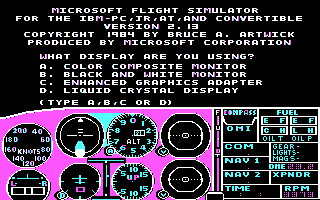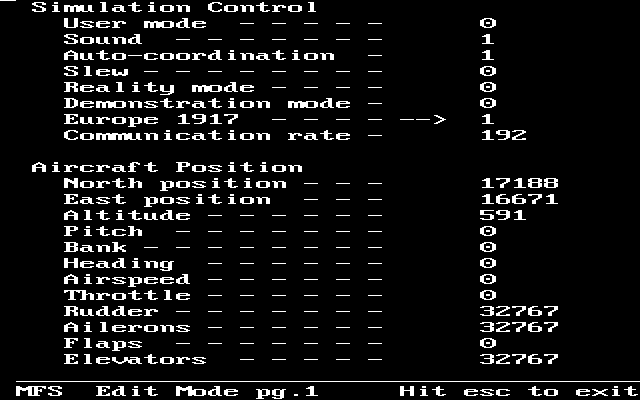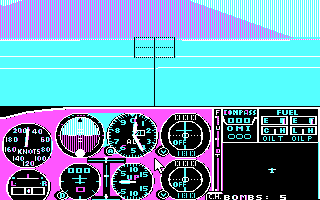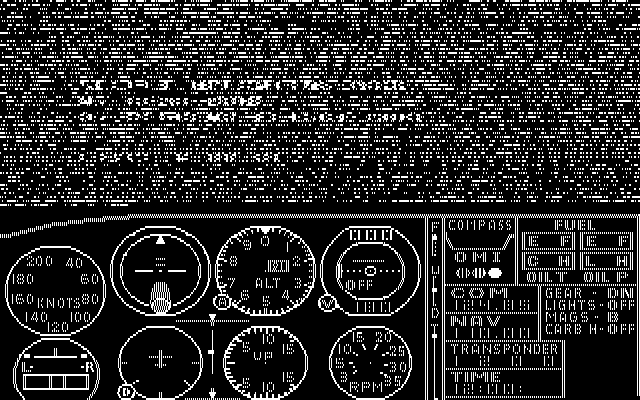# This is the configurationfile for DOSBox SVN_MB6. (Please use the latest version of DOSBox)
# Lines starting with a # are commentlines and are ignored by DOSBox.
# They are used to (briefly) document the effect of each option.
[sdl]
# fullscreen: Start dosbox directly in fullscreen. (Press ALT-Enter to go back)
# fulldouble: Use double buffering in fullscreen. It can reduce screen flickering, but it can also result in a slow DOSBox.
# fullresolution: What resolution to use for fullscreen: original or fixed size (e.g. 1024x768).
# Using your monitor's native resolution with aspect=true might give the best results.
# If you end up with small window on a large screen, try an output different from surface.
# windowresolution: Scale the window to this size IF the output device supports hardware scaling.
# (output=surface does not!)
# output: What video system to use for output.
# Possible values: surface, overlay, opengl, openglnb, ddraw.
# autolock: Mouse will automatically lock, if you click on the screen. (Press CTRL-F10 to unlock)
# sensitivity: Mouse sensitivity.
# waitonerror: Wait before closing the console if dosbox has an error.
# priority: Priority levels for dosbox. Second entry behind the comma is for when dosbox is not focused/minimized.
# pause is only valid for the second entry.
# Possible values: lowest, lower, normal, higher, highest, pause.
# mapperfile: File used to load/save the key/event mappings from. Resetmapper only works with the defaul value.
# usescancodes: Avoid usage of symkeys, might not work on all operating systems.
fullscreen=false
fulldouble=false
fullresolution=original
windowresolution=1024x768
output=ddraw
autolock=true
sensitivity=100
waitonerror=true
priority=higher,normal
mapperfile=mapper-SVN_MB6.map
usescancodes=true
[dosbox]
# language: Select another language file.
# machine: The type of machine DOSBox tries to emulate.
# Possible values: hercules, cga, tandy, pcjr, ega, vgaonly, svga_s3, svga_et3000, svga_et4000, svga_paradise, vesa_nolfb, vesa_oldvbe.
# vmemsize: Amount of video memory in megabytes.
# The maximum resolution and color depth the svga_s3 will be able to display
# is determined by this value.
# 0: 512k (800x600 at 256 colors)
# 1: 1024x768 at 256 colors or 800x600 at 64k colors
# 2: 1600x1200 at 256 colors or 1024x768 at 64k colors or 640x480 at 16M colors
# 4: 1600x1200 at 64k colors or 1024x768 at 16M colors
# 8: up to 1600x1200 at 16M colors
# For build engine games, use more memory than in the list above so it can
# use triple buffering and thus won't flicker.
#
# captures: Directory where things like wave, midi, screenshot get captured.
# memsize: Amount of memory DOSBox has in megabytes.
# This value is best left at its default to avoid problems with some games,
# though few games might require a higher value.
# There is generally no speed advantage when raising this value.
language=
machine=cga
#machine=vgaonly
vmemsize=0
captures=capture
memsize=1
[render]
# frameskip: How many frames DOSBox skips before drawing one.
# aspect: Do aspect correction, if your output method doesn't support scaling this can slow things down!.
# linewise: Draw the display line by line. Needed for certain special graphics effects in games and demos. Can be changed at runtime but will be put in effect at the next mode switch.
# char9: Allow 9-pixel wide text mode fonts.
# multiscan: Set this value to true to allow zooming gfx effects used in demos. It will disable several options such as scalers though.
# scaler: Scaler used to enlarge/enhance low resolution modes. If 'forced' is appended,
# then the scaler will be used even if the result might not be desired.
# Possible values: none, normal2x, normal3x, advmame2x, advmame3x, advinterp2x, advinterp3x, hq2x, hq3x, 2xsai, super2xsai, supereagle, tv2x, tv3x, rgb2x, rgb3x, scan2x, scan3x.
frameskip=0
aspect=false
linewise=false
char9=false
multiscan=false
scaler=normal3x
#scaler=hq3x
#scaler=rgb3x
[cpu]
# core: CPU Core used in emulation. auto will switch to dynamic if available and
# appropriate.
# Possible values: auto, dynamic, normal, simple.
# cputype: CPU Type used in emulation. auto emulates a 486 which tolerates Pentium instructions.
# Possible values: auto, 386, 486, pentium, 386_prefetch.
# cycles: Amount of instructions DOSBox tries to emulate each millisecond.
# Setting this value too high results in sound dropouts and lags.
# Cycles can be set in 3 ways:
# 'auto' tries to guess what a game needs.
# It usually works, but can fail for certain games.
# 'fixed #number' will set a fixed amount of cycles. This is what you usually
# need if 'auto' fails (Example: fixed 4000).
# 'max' will allocate as much cycles as your computer is able to
# handle.
# Possible values: auto, fixed, max.
# cycleup: Amount of cycles to decrease/increase with keycombos.(CTRL-F11/CTRL-F12)
# cycledown: Setting it lower than 100 will be a percentage.
core=auto
cputype=386
cycles=fixed 750
cycleup=10
cycledown=20
[mixer]
# nosound: Enable silent mode, sound is still emulated though.
# rate: Mixer sample rate, setting any device's rate higher than this will probably lower their sound quality.
# Possible values: 44100, 48000, 32000, 22050, 16000, 11025, 8000, 49716.
# blocksize: Mixer block size, larger blocks might help sound stuttering but sound will also be more lagged.
# Possible values: 1024, 2048, 4096, 8192, 512, 256.
# prebuffer: How many milliseconds of data to keep on top of the blocksize.
nosound=false
rate=44100
blocksize=1024
prebuffer=20
[midi]
# mpu401: Type of MPU-401 to emulate.
# Possible values: intelligent, uart, none.
# mididevice: Device that will receive the MIDI data from MPU-401.
# Possible values: default, win32, alsa, oss, coreaudio, coremidi, none.
# midiconfig: Special configuration options for the device driver. This is usually the id of the device you want to use.
# See the README/Manual for more details.
mpu401=intelligent
mididevice=default
midiconfig=
[sblaster]
# sbtype: Type of Soundblaster to emulate. gb is Gameblaster.
# Possible values: sb1, sb2, sbpro1, sbpro2, sb16, gb, none.
# sbbase: The IO address of the soundblaster.
# Possible values: 220, 240, 260, 280, 2a0, 2c0, 2e0, 300.
# irq: The IRQ number of the soundblaster.
# Possible values: 7, 5, 3, 9, 10, 11, 12.
# dma: The DMA number of the soundblaster.
# Possible values: 1, 5, 0, 3, 6, 7.
# hdma: The High DMA number of the soundblaster.
# Possible values: 1, 5, 0, 3, 6, 7.
# sbmixer: Allow the soundblaster mixer to modify the DOSBox mixer.
# oplmode: Type of OPL emulation. On 'auto' the mode is determined by sblaster type.
# All OPL modes are Adlib-compatible, except for 'cms'. sbtype=none
# together with oplmode=cms will emulate a Gameblaster.
# Possible values: auto, cms, opl2, dualopl2, opl3, none, hardware, hardwaregb.
# oplemu: Provider for the OPL emulation. compat might provide better quality (see oplrate as well).
# Possible values: default, compat, fast.
# oplrate: Sample rate of OPL music emulation. Use 49716 for highest quality (set the mixer rate accordingly).
# Possible values: 44100, 49716, 48000, 32000, 22050, 16000, 11025, 8000.
# hardwarebase: base address of the real hardware soundblaster:
# 210,220,230,240,250,260,280
sbtype=sb16
sbbase=220
irq=7
dma=1
hdma=5
sbmixer=true
oplmode=auto
oplemu=default
oplrate=44100
hardwarebase=220
[gus]
# gus: Enable the Gravis Ultrasound emulation.
# gusrate: Sample rate of Ultrasound emulation.
# Possible values: 44100, 48000, 32000, 22050, 16000, 11025, 8000, 49716.
# gusbase: The IO base address of the Gravis Ultrasound.
# Possible values: 240, 220, 260, 280, 2a0, 2c0, 2e0, 300.
# gusirq: The IRQ number of the Gravis Ultrasound.
# Possible values: 5, 3, 7, 9, 10, 11, 12.
# gusdma: The DMA channel of the Gravis Ultrasound.
# Possible values: 3, 0, 1, 5, 6, 7.
# ultradir: Path to Ultrasound directory. In this directory
# there should be a MIDI directory that contains
# the patch files for GUS playback. Patch sets used
# with Timidity should work fine.
gus=false
gusrate=44100
gusbase=240
gusirq=5
gusdma=3
ultradir=C:\ULTRASND
[speaker]
# pcspeaker: Enable PC-Speaker emulation.
# pcrate: Sample rate of the PC-Speaker sound generation.
# Possible values: 44100, 48000, 32000, 22050, 16000, 11025, 8000, 49716.
# tandy: Enable Tandy Sound System emulation. For 'auto', emulation is present only if machine is set to 'tandy'.
# Possible values: auto, on, off.
# tandyrate: Sample rate of the Tandy 3-Voice generation.
# Possible values: 44100, 48000, 32000, 22050, 16000, 11025, 8000, 49716.
# disney: Enable Disney Sound Source emulation. (Covox Voice Master and Speech Thing compatible).
pcspeaker=true
pcrate=44100
tandy=auto
tandyrate=44100
disney=false
[joystick]
# joysticktype: Type of joystick to emulate: auto (default), none,
# 2axis (supports two joysticks),
# 4axis (supports one joystick, first joystick used),
# 4axis_2 (supports one joystick, second joystick used),
# fcs (Thrustmaster), ch (CH Flightstick).
# none disables joystick emulation.
# auto chooses emulation depending on real joystick(s).
# (Remember to reset dosbox's mapperfile if you saved it earlier)
# Possible values: auto, 2axis, 4axis, 4axis_2, fcs, ch, none.
# timed: enable timed intervals for axis. Experiment with this option, if your joystick drifts (away).
# autofire: continuously fires as long as you keep the button pressed.
# swap34: swap the 3rd and the 4th axis. can be useful for certain joysticks.
# buttonwrap: enable button wrapping at the number of emulated buttons.
joysticktype=auto
timed=true
autofire=false
swap34=false
buttonwrap=false
[serial]
# serial1: set type of device connected to com port.
# Can be disabled, dummy, modem, nullmodem, directserial.
# Additional parameters must be in the same line in the form of
# parameter:value. Parameter for all types is irq (optional).
# for directserial: realport (required), rxdelay (optional).
# (realport:COM1 realport:ttyS0).
# for modem: listenport (optional).
# for nullmodem: server, rxdelay, txdelay, telnet, usedtr,
# transparent, port, inhsocket (all optional).
# Example: serial1=modem listenport:5000
# Possible values: dummy, disabled, modem, nullmodem, directserial.
# serial2: see serial1
# Possible values: dummy, disabled, modem, nullmodem, directserial.
# serial3: see serial1
# Possible values: dummy, disabled, modem, nullmodem, directserial.
# serial4: see serial1
# Possible values: dummy, disabled, modem, nullmodem, directserial.
serial1=modem listenport=23
serial2=dummy
serial3=disabled
serial4=disabled
[printer]
# printer: Enable printer emulation.
# dpi: Resolution of printer (default 360).
# width: Width of paper in 1/10 inch (default 85 = 8.5'').
# height: Height of paper in 1/10 inch (default 110 = 11.0'').
# printoutput: Output method for finished pages:
# png : Creates PNG images (default)
# ps : Creates Postscript
# bmp : Creates BMP images (very huge files, not recommend)
# printer : Send to an actual printer (Print dialog will appear)
# multipage: Adds all pages to one Postscript file or printer job until CTRL-F2 is pressed.
# docpath: The path where the output files are stored.
# timeout: (in milliseconds) if nonzero: the time the page will
# be ejected automatically after when no more data
# arrives at the printer.
printer=true
dpi=360
width=85
height=110
printoutput=printer
multipage=true
docpath=.
timeout=0
[parallel]
# parallel1: parallel1-3 -- set type of device connected to lpt port.
# Can be:
# reallpt (direct parallel port passthrough using Porttalk),
# file (records data to a file or passes it to a device),
# printer (virtual dot-matrix printer, see [printer] section)
# Additional parameters must be in the same line in the form of
# parameter:value.
# for reallpt:
# Windows:
# realbase (the base address of your real parallel port).
# Default: 378
# ecpbase (base address of the ECP registers, optional).
# Linux: realport (the parallel port device i.e. /dev/parport0).
# for file:
# dev:<devname> (i.e. dev:lpt1) to forward data to a device,
# or append:<file> appends data to the specified file.
# Without the above parameters data is written to files in the capture dir.
# Additional parameters: timeout:<milliseconds> = how long to wait before
# closing the file on inactivity (default:500), addFF to add a formfeed when
# closing, addLF to add a linefeed if the app doesn't, cp:<codepage number>
# to perform codepage translation, i.e. cp:437
# for printer:
# printer still has it's own configuration section above.
# parallel2: see parallel1
# parallel3: see parallel1
parallel1=printer
parallel2=disabled
parallel3=disabled
[dos]
# xms: Enable XMS support.
# ems: Enable EMS support. The default (=true) provides the best
# compatibility but certain applications may run better with
# other choices, or require EMS support to be disabled (=false)
# to work at all.
# Possible values: true, emsboard, emm386, false.
# umb: Enable UMB support.
# keyboardlayout: Language code of the keyboard layout (or none).
# files: Number of file handles available to DOS programs. (equivalent to "files=" in config.sys)
xms=false
ems=false
umb=false
keyboardlayout=auto
files=127
[ipx]
# ipx: Enable ipx over UDP/IP emulation.
ipx=true
[ne2000]
# ne2000: Enable Ethernet passthrough. Requires [Win]Pcap.
# nicbase: The base address of the NE2000 board.
# nicirq: The interrupt it uses. Note serial2 uses IRQ3 as default.
# macaddr: The physical address the emulator will use on your network.
# If you have multiple DOSBoxes running on your network,
# this has to be changed for each. AC:DE:48 is an address range reserved for
# private use, so modify the last three number blocks.
# I.e. AC:DE:48:88:99:AB.
# realnic: Specifies which of your network interfaces is used.
# Write 'list' here to see the list of devices in the
# Status Window. Then make your choice and put either the
# interface number (2 or something) or a part of your adapters
# name, e.g. VIA here.
ne2000=true
nicbase=300
nicirq=9
macaddr=AC:DE:48:88:99:AA
realnic=1
[autoexec]
# Lines in this section will be run at startup.
Boot fsim1.img




